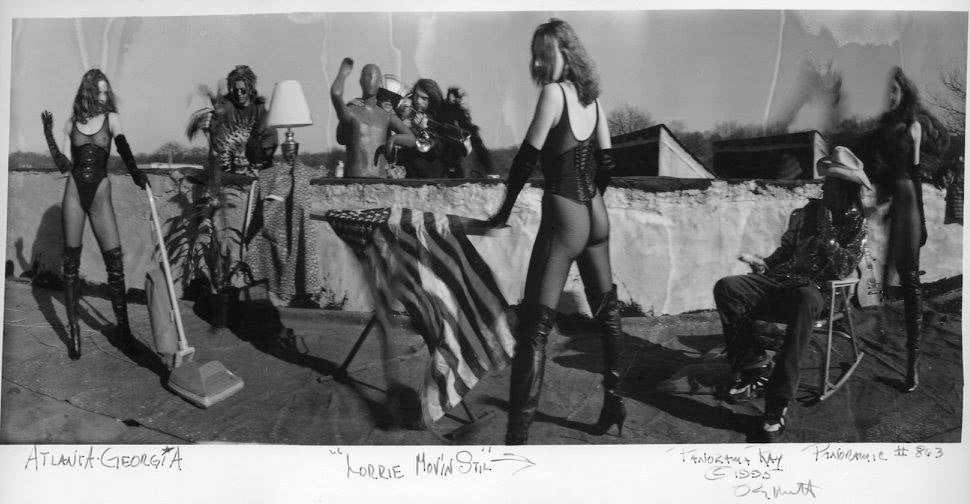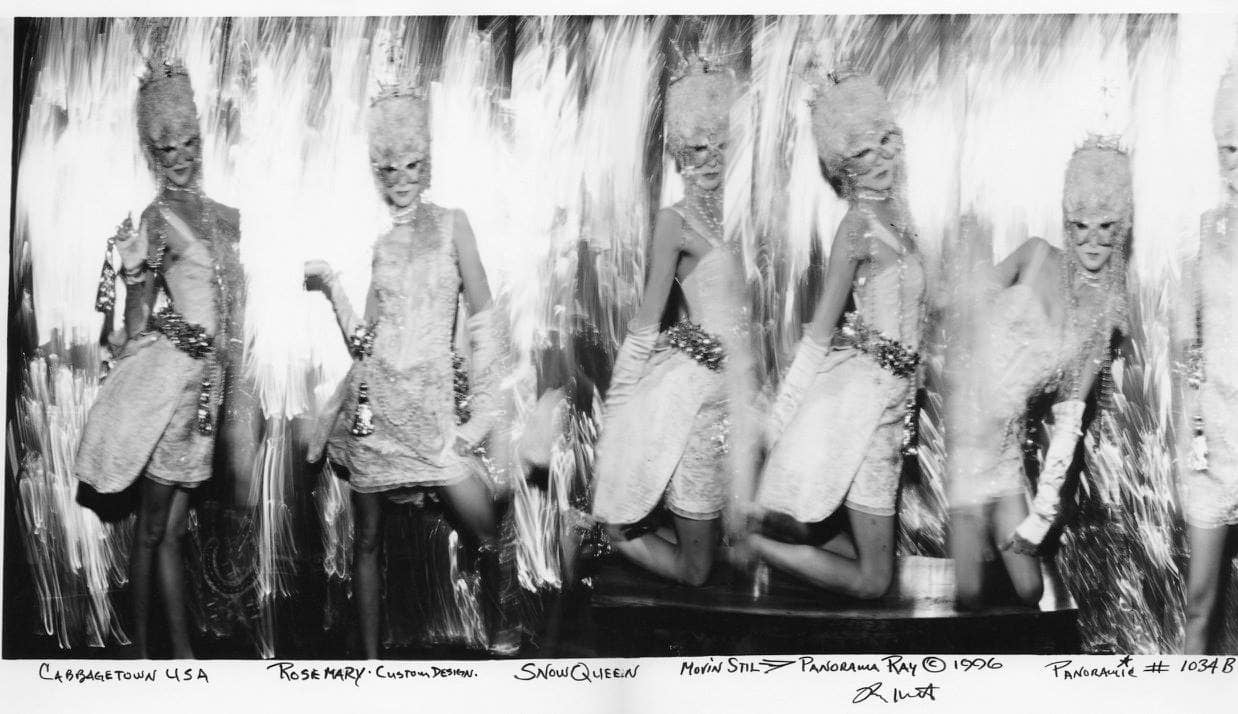
In 1688, a very cynical Swiss doctor, Johannes Hoffer, coined the word nostalgia, derived from the Greek root words nostos — meaning “return home” — and algos — “pain.” He defined nostalgia as a “neurological disease of essentially demonic cause.” Military doctors in the 18th and 19th centuries believed that cases of nostalgia among Swiss mercenaries abroad was caused by brain damage in the soldier’s ears and brain cells due to the constant clanging of cow bells in the Alps. Nostalgia, as a concept, hasn’t fared too well in the modern imagination either, being thought of as something that can potentially keep us tied to a past we cannot ever recapture, disconnecting ourselves from the present, and perhaps even preventing future progress.
I had a strange experience at the “Panorama Ray Remembered” exhibition at Eyedrum recently; I experienced a sense of nostalgia for a time and place that I never experienced. Panorama Ray was a photographer and painter active in Cabbagetown in the 1990s, back when Cabbagetown was a working class neighborhood and back when it was a neighborhood that young artists could afford to live in. From what I understand, and from what I see in Panorama Ray’s paintings and photographs, Cabbagetown was a community abuzz with creative energy, and maybe it still is, but certainly less dangerously so, and there can be no beauty without a little danger.
During the 1990s, I lived in Athens, Georgia, in a similarly close-knit creative community. The surprising thing is, while at Eyedrum, I wasn’t thinking as much about my real life experiences in Athens as my imaginary ones, taking place in the streets of 1990s Cabbagetown, the Cabbagetown depicted in Panorama Ray’s photographs. But the Cabbagetown streets are very different today. The party is over. I sometimes imagine hearing unsourced echoing voices, children playing, the sound of ghosts.

Panorama Ray Herbert Jr. moved to Atlanta from Atlantic City, New Jersey, in the late 1980s. By this time he had already worked as a photographer for Presidents Ford, Carter, and Reagan. He quickly set up his home and studio on Carroll Street in Cabbagetown, and began documenting life in Atlanta in paint and in panoramic photographs, which he took using his Eastman Kodak #10 Cirkut Camera (1904). Some of his subjects included KKK rallies and Civil War reenactments, but the best photographs are the one that show everyday life in Cabbagetown that are a celebration of community identity. He had a talent for bringing people together and coaxing out their collective creative spirit. It shows in his panoramic photographs of his neighbors, the streets filled with people, many in costumes and exaggerated poses, radiating what can only be called a soulful, eccentric kind of joy.

But Ray was more than his art; he lived an artful life. Ray’s loud, eccentric, and generous spirit quickly won over the neighborhood citizens, whom he dubbed “Cabbageheads.” Soon Ray was given the honor of being the “Mayor of Cabbagetown.” Ray documented the lives of neighbors in his column “Cabbagetown Chronicles” for Hi Point Magazine, elevating the downtrodden to mythological hero status, and sharing tales of the drug addicted with compassionate realism.
Ray was also a consummate teller of tall tales, some of which were shared with me by the exhibition’s curators Shawn McElroy and Rosemary Kimble. As one story went, Elvis wasn’t dead but secretly living in Cabbagetown, and even had a few girlfriends . . . which was why, according to Panorama Ray’s logic, so many of the children in Cabbagetown looked like Elvis. Ray would paint signs declaring “Elvis Lives Here” and would hang them all over the neighborhood. These children would often play in the empty lot next to Ray’s home on Carroll Street. Ray, who would sleep late, would yell at the children if they were too loud. Eventually the local children gave the lot its current name, “Whisper Park,” because one had to whisper in order to play there in the morning.
When Atlanta was awarded the honor of hosting the 1996 Summer Olympic Games, Ray, like most of us, got caught up in the excitement. Many of Ray’s works celebrate the Olympics. Ray would tell stories of how Atlanta would become “intergalactically famous,” with space aliens dropping in for a visit, and how Coca-Cola blimps would hover overhead and drop gold coins down on the people. Both blimps and space aliens reoccur in Ray’s Olympic-themed works.
The Olympics, ironically, was the catalyst, perhaps, for Cabbagetown’s gentrification. Much of Ray’s paintings, a few of which are included in the exhibition, are on old doors pulled out of houses that were being renovated. Ray had a front row seat to the changing character of Cabbagetown. He was a champion of his community, and when the centerpiece of Cabbagetown, the Fulton Bag and Cotton Mills (1881-1978) was threatened with demolition to make way for new apartments and condos. Ray quickly became an advocate for the historic site and hung his handpainted “Save the Mill” signs all over the city. The historic site survives today as the “Fulton Cotton Mill Lofts” and “The Stacks.”

Cabbagetown is different today. It is a beautiful place and you are less likely to be held up here than in other parts of the city. It is a great place to raise kids. Truth be told, I kind of like it. But is it still the crucible of creativity that it was in the 1990s? I can’t say with any certainty; I didn’t live in Cabbagetown in the 1990s so I have no point of reference. It is safe to say, though, that gentrification won. It now marches on to other parts of the city and at an alarming rate — twice the national average . Atlanta ranks number five among the top 50 U.S. cities experiencing gentrification.
The next place to be transformed is the southern edge of Cabbagetown, the two-mile industrial corridor along Memorial Drive, from the State Capitol to Moreland Avenue. Since early 2014, the Memorial Drive corridor has seen the beginnings of 26 new construction projects. Pace Properties CEO David Cochran foresees the strip as being “the next Inman Park.” Soon, the familiar Memorial Drive corridor will also become a nostalgic memory. Local favorites like Stone Soup Kitchen are already closing their doors due to increases in rent.

Recent studies in the UK have shown that nostalgia is a beneficial thing, healthy to our psyche . This is even more surprising because the same studies show that most experiences of nostalgia are triggered by a sudden sense of loss. Seeing the Panorama Ray show at Eyedrum triggered that sense of loss in me — of younger and wilder days in wilder neighborhoods, roving bands of artists united against the world, at least in my own romantic imagination. Like Cabbagetown, all of those places where I would roam are now gone, in many cases literally bulldozed down.
Things cannot stay the same and to wish things to stay the same just isn’t healthy . . . I believe Atlanta to be a city with tremendous possibilities, but if I got anything out of the Panorama Ray show and my surprising experience of nostalgia, it is that we should use our nostalgia as guiding points for responsible development, to help create integrated communities. Gentrification is inevitable, but it need not be a monster. The benefits of gentrification can and should be shared by all. There must be ways that we can deal with the mass displacement too often caused by gentrification. The issue is a many-headed hydra and also beyond the scope of this article. But my nostalgia for 1990’s Cabbagetown, spurred by Panorama Ray’s work, has in turn spurred an interest in learning about ways to influence positive growth and responsible development in Atlanta.
“Panorama Ray Remembered,” curated by Shawn McElroy and Rosemary Kimble, is on view at Eyedrum through September 3. The gallery is open on Fridays and Saturdays, 5-8pm, and Sundays, 2pm to 6pm. A closing reception will be on September 2, 7-10pm.




